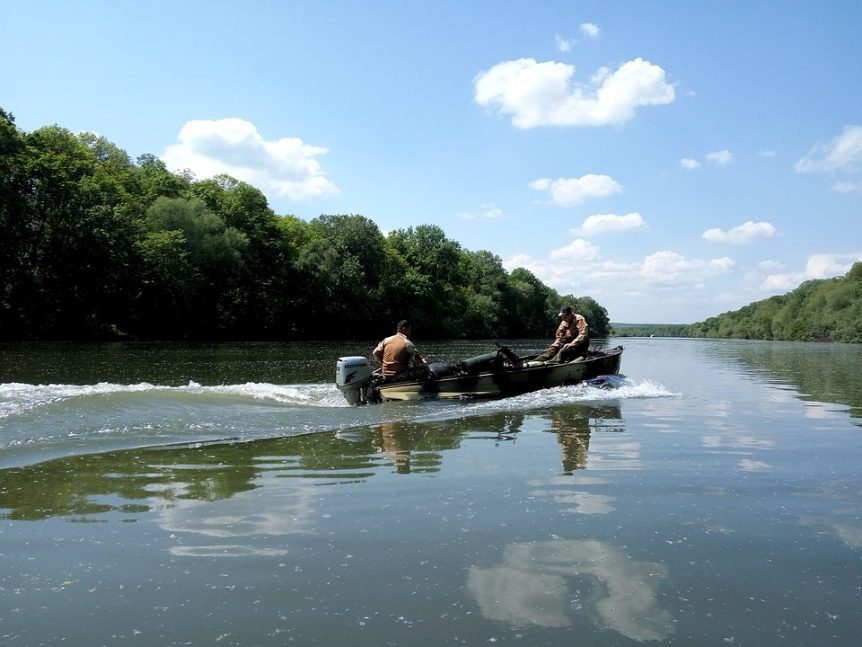Head Up Rivers For Summertime Reservoir Bass
When your favorite lake turns into a hot tub full of personal watercraft and recreational boaters this summer, it’s time to head for narrower and cooler waters. Heading up river to is a great way to target summertime reservoir bass.
Taking a float trip on a stream is one way to experience excellent fishing in the heat of summer, but if you prefer to fish impoundments there it still a viable alternative. Rather than fight the boat traffic and fish deep for sluggish bass, you can run up the tributaries of your favorite reservoir and find active bass in shallow cover. Typically in reservoirs water tends to stratify and you get a thermocline that starts to build up, but this never occurs in the river because there is always moving water to some degree.
Here are some tips on how to catch summertime bass from reservoir tributaries.
Go With The Flow
While fishing upriver for summertime reservoir bass focus on eddies near steeper banks in the tributaries when there’s some water flow either from power generation or after a heavy rain. In both situations the flow generates more oxygen in the water and seems to turn on the fish. The shad are more active there, which in turn makes the bass more active.
Mud flats in tributaries keep the water off-color throughout the summer. If the area gets rain that produces some current, the fishing can change because the water will get dirtier then.
Depending on the type of structure, bass will be holding anywhere from 6 inches to 8 feet deep in the tributary. If the water is clear and you are fishing a ledge, bass will be at the bottom of the ledge. However if the water is dirty, bass will stay on top of the ledge. If you are fishing a drop-off, bass stay towards the surface in dirty water, but in clear water the fish tend to hold closer to the bottom. Some bass can caught in feeder creeks of the tributaries, but the main channel banks of the tributaries usually attract more shad and active bass.
For aggressive bass, burn a crankbait or spinnerbait around any cover in the upper reaches of the tributary. When bass are inactive, key on the lower end of the tributary and pitch a jig along channel swing points where bass tend to stay along the rocky bottom of the channel and feed on crawfish.
Go to the extreme
Run up as far as your boat can go on a tributary to get away from other anglers to find the biggest summertime reservoir bass.
Before heading too far up river though, make a stop at the last riffle heading into the lake. There is usually a hole right below where you run into current that puts a lot of oxygen in the water and activates bass. After hitting this spot, navigate up the river as far as your boat can go and fish the main river banks.
Bass in the river usually stay 2 to 3 feet deep and hold on rocks, stumps, logs or anything else that breaks the current. Sometimes bass will just key on the still water such as a small eddy in this riverine section. Productive lures to throw in the rivers include square-bill crankbaits, jigs, spinnerbaits and plastic grubs. A plastic worm bounced downstream with the current is a natural-looking presentation that also produces well in the summertime. Since river fish tend to face upstream waiting for the current to sweep a meal into their strike zone, you should retrieve your lure with a more natural presentation by casting upstream and reeling it in as it flows down with the current.

Targeting Timber For Summertime Reservoir Bass
On reservoirs loaded with flooded timber, summertime bass in the tributaries position around big standing timber or laydowns right off the creek channel swings where it cuts into or breaks away from the bank when water is running. The best areas are where a channel ledge drops off from 4 feet to 15 feet of water. Concentrate on the outside edges of the channel swing, but make sure you spend a little time fishing the inside edge of a swing that has a wide “S” turn.
These channel swing bass can be taken on fast-moving lures such as spinnerbaits and square-bill crankbaits or by flipping a jig. In either case, work quickly down the bank and cover a lot of water. If water flow is minimal, burn a square-bill crankbait through the timber to trigger a reaction strike and cover more water than you can with a slow-moving plastic worm.
If you catch a quality bass on the crankbait, then turn around and work the spot with a jig or worm because bass tend to bunch up in areas on the river. A Zara Spook or a magnum-size plastic worm also work better around the channel edges, especially where the river widens out in to a flat with standing hardwoods.
Are You Missing Out?




